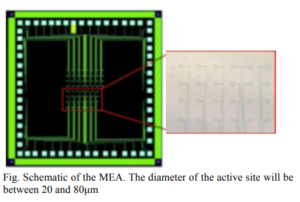Réseaux de microéléctrodes à la base de SiC pour la caractérisation ex-vivo
Publié le : 23 novembre 2020
 MSc subject
MSc subject
SiC microelectrode arrays for ex-vivo characterization
Thesis background :
Nervous system damage and disorders come in a variety of forms and rarely heal over time. Millions of individuals worldwide suffer from physical disabilities that are a direct result of damage to their central nervous system (CNS); thousands more have lost limbs due to wartime violence and have suffered damage to their peripheral nervous system (PNS). In addition, neurodegenerative diseases and conditions, such as Alzheimer, Parkinson’s disease, epilepsy, depression, and schizophrenia, are affecting a growing number of individuals globally. The brain machine interface (BMI) or neurointerface technology also known as the brain-computer interface (BCI) shows great promise to be able to provide therapeutics for these types of injuries [1].
In the field of BMI devices, researchers are not still able to produce clinically viable solutions that meet the requirements of long-term operation due to biological, material, and mechanical issues. Most of the issues are due to biotic and abiotic sources related to the employed materials for BMI fabrication. Biotic mechanisms of failure are related to the brain inflammatory response to implanted system. Abiotic mechanisms correspond to the stability of the implanted system in the brain environment.
Objective :
Hereby, we propose the use of SiC as the base and single material for the fabrication of the electrodes in BMI systems. Towards this purpose microelectrode arrays (MEAs) will be fabricated for the in-vitro investigation of SiC as electrode material.
Why SiC?
Various in vitro and in vivo studies have shown that this material is suitable for use in biomedical devices [2, 3, 4].
Indeed, SiC is a semiconductor that is completely chemically inert within the physiological environment, resists oxidative corrosion and has demonstrated no appreciable toxicity [5, 6, 7].
In addition, SiC electrode probes are characterized by an excellent neural compatibility. Cubic silicon carbide (3C-SiC) is highly compatible with central nervous system (CNS) tissue in a murine mouse model [8]. In a later study [9], it has been demonstrated a robust all3C-SiC intracortical neural interface (INI) for advanced bionics and brain-machine interfaces (BMI). Similar devices based on 4H-SiC polytype exhibited better performance in terms of electrochemical response [10, 11, 12].
SiC can also address successfully abiotic issues. Silicon carbide (SiC) is extremely suitable for the fabrication of the implantable electrode incorporating all three functions: support, conductors and insulation. Indeed, SiC current technology maturity (many SiC devices are commercially available) offers this possibility. The support can be micromachined using conventional methods available to the Si industry. Doping the semiconductor into the metallic regime can create the conductors. Lastly, the insulation can be achieved by using amorphous insulating SiC.
By reducing the heterogeneity of the materials comprising microelectrode arrays, we can improve the reliability of these devices (abiotic response). Other semiconductors fall short in providing a platform for single material electrodes. In addition to the mechanical limitations of Si, its low bandgap reduces the blocking voltage and limits electrical isolation [13].
Indeed, SiC-based diodes have higher turn-off voltage (well above 1V) than Si (0.6V) warranting a small cross-talk in multi-electrode probes. Many semiconductors are toxic (aka gallium arsenide [14]), experience anodic oxidation and corrosion (diamond [15], gallium nitride[16])), or have extremely large bandgap and resistivity (boron nitride [17]).
In addition to the excellent bio- and hemocompatibility, SiC has a fracture toughness 4-5 times greater than Si as well as better buckling characteristics. Thus, SiC probes can be thinner and more compliant than the current implantable devices, which may lead to a reduced biotic response.
Workplan :
In the frame of the present thesis, the MSc 
candidate will develop the initial stages for the
development of a new implantable electrode based
on SiC material. More precisely planar
microelectrode arrays will be fabricated and
characterized. A typical configuration for such MEA
is shown in the figure aside. The comprehensive
effort will include SiC electrode fabrication and
electrochemistry characterization.
The work will be principally performed in the IMEPLAHC in Grenoble in collaboration with the lab
MRG-FORTH in Heraklion, Greece.
The main steps of the workplan are:
- Detailed bibliography.
- Design of the MEA and the corresponding process steps
- Design of the photolithography mask set
- Optimization of technology steps (plasma etching, ohmic contacts)
- Fabrication of the MEA
- Electrochemical evaluation of the MEA
Contact:
For further information contact:
Dr. Konstantinos Zekentes , Konstantinos.Zekentes@grenoble-inp.fr
References :
[1] J. P. Donoghue, « Bridging the brain to the world: a perspective on neural interface systems, » Neuron, vol. 60, pp. 511-21, Nov 6 2008.
[2] R. Yakimova, R.M. Petoral, G.R. Yazdi, C. Vahlberg, A. Lloyd Spetz, and K. Uvdal: Surface functionalization and biomedicalapplications based on SiC, J. Phys. D: Appl. Phys.40, 6435–6442 (2007)
[3] S.E. Saddow, C.L. Frewin, C. Coletti, N. Schettini, E. Weeber, A. Oliveros, and M. Jarosezski: Single crystal silicon carbide: Abiocompatible and hemocompatible semiconductor for advanced bio-medical applications, Mater. Sci. Forum 679–680, 824–830 (2011).
[4] C. Coletti, M.J. Jaroszeski, A. Pallaoro, M. Hoff, S. Iannotta, andS.E. Saddow: Biocompatibility and wettability of crystalline SiCand Si surfaces. In29th Annual International Conference of theIEEE Engineering in Medicine and Biology Society, Lyon, France,2007; pp. 5849–5852.17. C.L. Frewin, M. Jarosze
[5] Kordina, O. & Saddow, S. E. 2004. Silicon carbide overview. In: SADDOW, S. E. & AGARWAL, A. (eds.) Advances in
Silicon Carbide Processing and Applications. 1 ed. Boston, MA, U.S.A.: Artech House, Inc.
[6] Saddow, S. E. (ed.) 2011. Silicon Carbide Biotechnology: A Biocompatible Semiconductor for Advanced Biomedical Devices and Applications, Amsterdam: Elsevier.
[7] SiC biotechnology for advanced biomedical applications, 2013. Presentation. Directed by Saddow, S. E. University of Sao Paulo, Sao Carlos, Brasil.
[8] C.L.Frewin, C.Locke, L.Mariusso, E.J.Weeber, and S.E.Saddow, « Silicon Carbide Neural Implants: in vivo Neural Tissue Reaction, » Neural Engineering (NER), 6th International IEEE/EMBS Conference on, pp. 661 – 664, 2013.
[9] M. Gazziro et al., « Transmission of wireless neural signals through a 0.18µm CMOS low-power amplifier, » 2015 37th Annual International Conference of the IEEE Engineering in Medicine and Biology Society (EMBC), Milan, 2015, pp. 5094- 5097. doi: 10.1109/EMBC.2015.7319537
[10] Bernardin, E., Frewin, C. L., Dey, A., Everly, R., Ul Hassan, J., Janzén, E., Pancrazio, J. & Saddow, S. E. 2016.Development of an all-SiC neuronal interface device. MRS Advances, FirstView, 1-6, and in http://www.usf.edu/engineering/ee/documents/usfutd.pdf
[11] Evans K. Bernardin, Christopher L. Frewin, Richard Everly, Joseph J. Pancrazio and Stephen E. Saddow, “3C-Silicon Carbide Intracortical Neural Interfaces”, presented in 21 Annual Meeting of North America Neuromodulation Society (NANS18)
[12] Evans K. Bernardin, Christopher L. Frewin, Richard Everly, Jawad Ul Hassan and Stephen E. Saddow, Demonstration of a Robust All-Silicon-Carbide Intracortical Neural Interface, Micromachines 2018, 9(8): 412.
[13] Park, J., Park, K.-S., Won, J.-I., Kim, K.-H., Koo, S., Kim, S.-G. & Mun, J.-K. 2017. Control of pn-junction turn-on voltage in 4H-SiC merged PiN Schottky diode. Applied Physics Letters, 110, 142103.
[14] Tanaka, A. 2004. Toxicity of indium arsenide, gallium arsenide, and aluminium gallium arsenide. Toxicology and Applied Pharmacology, 198, 405-411.
[15] Kashiwada, T., Watanabe, T., Ootani, Y., Tateyama, Y. & Einaga, Y. 2016. A Study on Electrolytic Corrosion of BoronDoped Diamond Electrodes when Decomposing Organic Compounds. ACS Applied Materials & Interfaces, 8, 28299-28305.
[16] Pakes, A., Skeldon, P., Thompson, G. E., Fraser, J. W., Moisa, S., Sproule, G. I., Graham, M. J. & Newcomb, S. B. 2003. Anodic oxidation of gallium nitride. Journal of Materials Science, 38, 343-349.
[17] Minghu, P., Liangbo, L., Wenzhi, L., Soo Min, K., Qing, L., Jing, K., Mildred, S. D. & Vincent, M. 2016. Modification of the electronic properties of hexagonal boron-nitride in BN/graphene vertical heterostructures. 2D Materials, 3, 045002.



 Contactez-nous
Contactez-nous Plan d’accès
Plan d’accès









